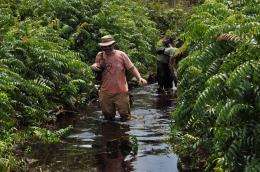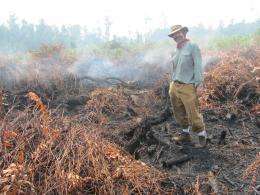Scientist tracks Indonesian carbon emissions

An ill-fated plan to convert nearly 2.5 million acres of Kalimantan peat swamp forest into rice paddies has contributed to Indonesia becoming the third-largest emitter of carbon, according to SDSU professor Mark Cochrane, a senior scientist at the Geospatial Sciences Center for Excellence.
Through a three-year, $2.2 million grant from NASA, Cochrane will use satellite imaging, field studies and modeling to help the Indonesian Forest Research and Development Agency assess the progress being made to reduce these emissions. He collaborates with carbon emissions expert Robert Yokelson, a chemistry professor from the University of Montana. The grant is part of NASA's global carbon monitoring program that contribute to an international focus on reducing emissions due to deforestation.
Peat swamp forests
The Mega Rice Project, which began in 1996, sought to clear land in Borneo's ancient peat swamp forests to raise enough rice to feed the Indonesian population, Cochrane explained. But the forest does not contain soil that will support crops.
"It was a giant catastrophe," said Cochrane, who has done similar work on deforestation in Australia and Brazil.
Jack Rieley, director of the Kalimantan Tropical Peat Swamp Forest Research Project and Vice President of the International Peat Society, called the project, "the most glaring misuse of tropical peatland in recent times."
Former Indonesian President Suharto authorized construction of nearly 2,900 miles of channels to drain the peat swamps and then loggers cleared the trees.

The peat forest soils consist of large accumulations of dead organic matter, some it tens of thousands of years old, more than 20 feet deep, explained Cochrane. Under normal circumstances, these water-logged, oxygen-starved peat domes don't decay or burn.
When the land is drained, the organic matter compacts, decays and releases carbon, Cochrane said. "It's like a block of ice evaporating in your refrigerator."
Release of carbon
Fires accelerate the oxidation process and, especially during dry years, there are many uncontrolled fires in the cleared areas, according to Cochrane, who has studied wildfires for more than 20 years. Indonesians accidentally ignite peat fires while burning to clear the peat surface for logging, hunting, fishing and farming.
A German research team estimated that the 1997 peat and forest fires during El Niño released between 0.87 and 2.57 billion tons of carbon into the atmosphere.
Smoldering peat fires slowly burn thin layers of the organic matter but can only be extinguished when the land floods, Cochrane explained. Peat fires eat into the ground surface and release huge amounts of carbon, much more than typical forest fires do.
These peat fires can last for weeks or months, creating thick smoke that hampers travel and poses significant human health risks. Cochrane hopes to be able to figure out which fires are most likely to result in peat fires.
Damage from fires
To do this, he will examine fire data from 1996 to get a more quantitative estimate of how much of the atmospheric damage is occurring due to these fires.
"Carbon emissions from land cover change are very significant globally," Cochrane said, estimating the impact can be the equivalent of 40 percent of all fossil fuel emissions on the planet during some years. Internationally, countries can get credit for verifiably reducing their carbon emissions.
Whether the peat forest ecosystem can be restored, Cochrane said, "will depend on how serious they are about reestablishing the hydrology." That would mean blocking drainage channels now used as highways, effectively keeping out the people who are lighting the fires.
Provided by South Dakota State University


















